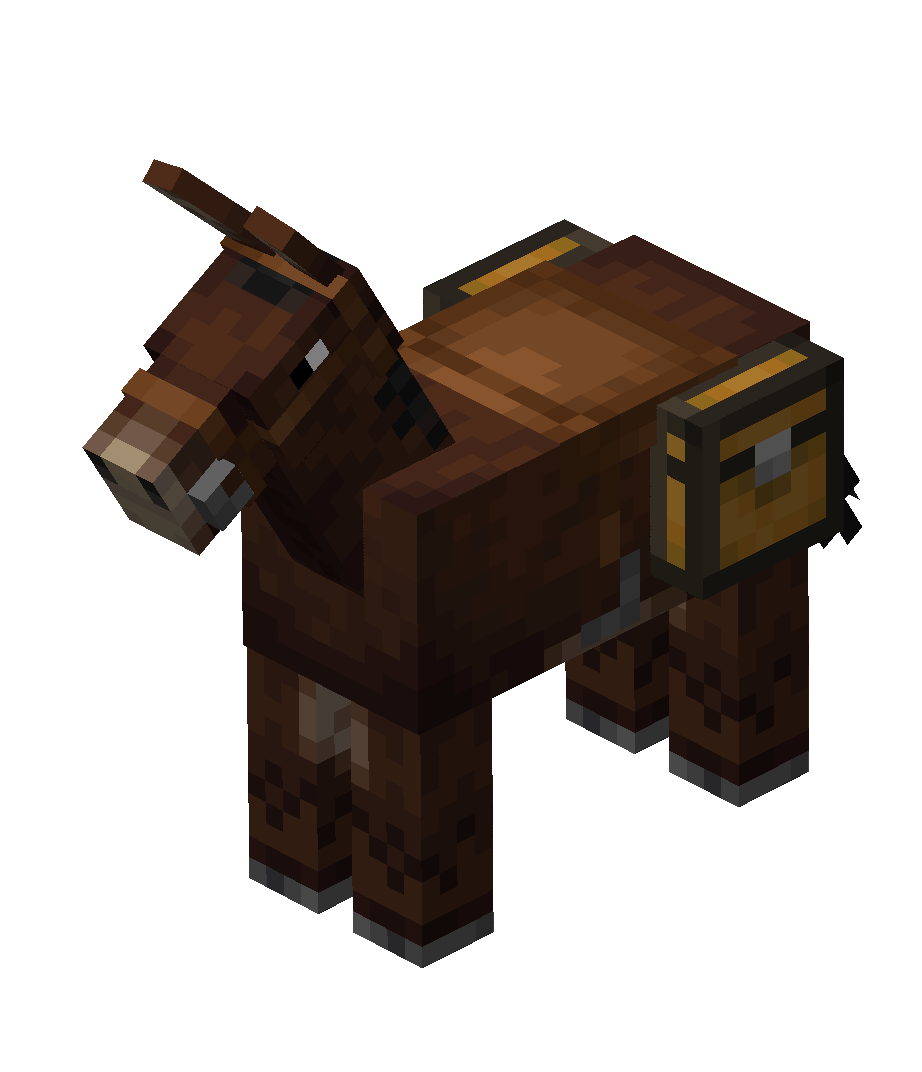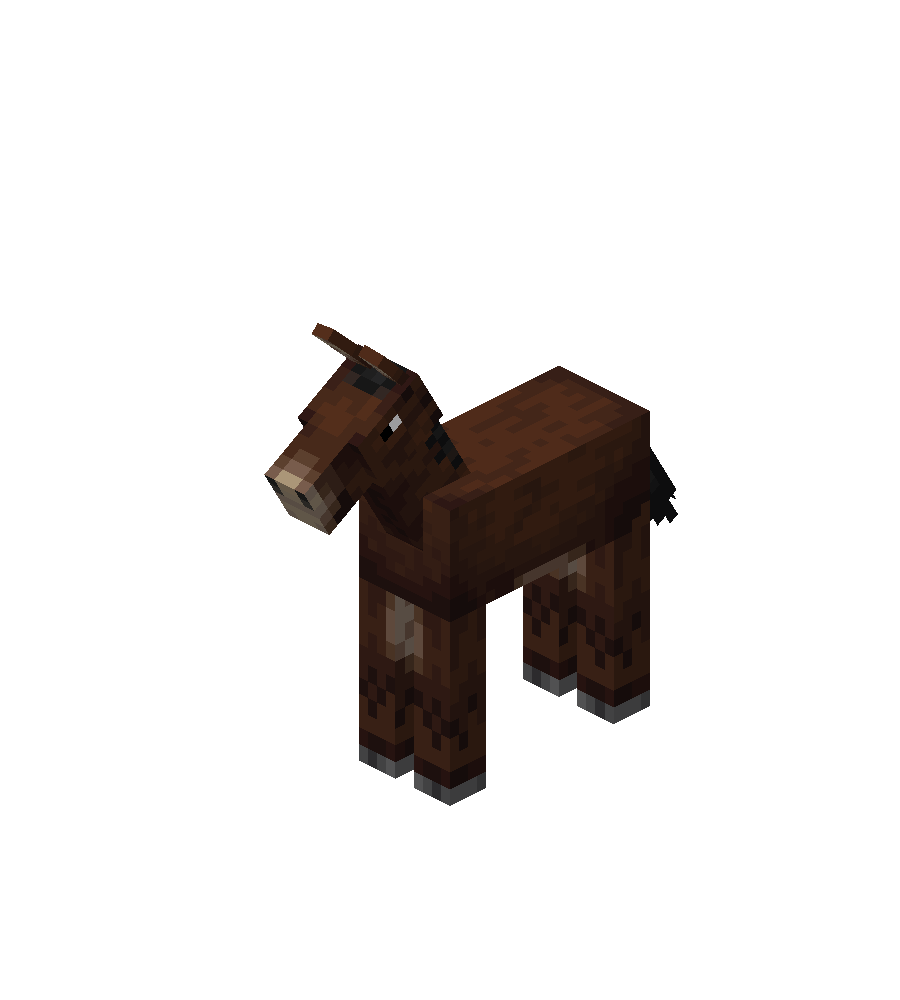что ест мул в майнкрафте
Майнкрафт: Как разводить лошадей
Создание фермы в Майнкрафте – это не то же самое без собственного табуна лошадей. К счастью, как и других животных в Minecraft, лошадей довольно легко приручить и развести.
Вот все, что вам нужно сделать, чтобы создать свою собственную семью лошадей: приручение, разведение и какие характеристики детеныши лошадей могут получить от своих родителей. Это руководство также расскажет все, что вам нужно знать о лошадях, ослах и мулах.
Во-Первых, Вам Нужно Приручить Лошадей
Вы не можете разводить диких лошадей, их нужно сначала приручить. Приручить лошадь в Майнкрафте очень просто, и вы можете сделать это еще до того, как у вас появится седло.
Подойдите к лошади в дикой природе. Нажмите на лошадь пустой рукой, как если бы вы пытались использовать предмет. Это поместит вас на спину лошади. Лошади не очень любят кататься верхом, и животному может потребоваться несколько попыток, чтобы успокоиться.
Существует пороговое значение того, сколько времени нужно, чтобы приручить лошадь: каждый раз, когда вы садитесь на спину животного, вы в основном приручаете его на 5 очков, и есть магическое число где-то между 0-99, которое вы должны ударить перед лошадью это твое. Это число случайное и разное для каждой лошади. Некоторых лошадей нужно приручить дольше, чем других.
Еще несколько советов:
Как Разводить Лошадей В Майнкрафт
Итак, вы приручили двух лошадей и теперь готовы к их разведению. Вам понадобится золотая морковь или золотые яблоки. Ага, видимо, у лошадей дорогой вкус. Накормите по одной золотой морковке или золотому яблоку каждой лошади, и вы увидите, как они входят в режим «любви», а из их голов вырываются сердца. Это означает, что они готовы к размножению.
Через короткое время лошади произведут на свет детеныша, называемого жеребенком. Эти маленькие парни милые, но если вы хотите, чтобы они выросли быстро, вы можете начать кормить их большим количеством еды. В конце концов, даже ферма с большим количеством сельскохозяйственных культур не обходится без лошадей.
Характеристики жеребенка будут основаны на характеристиках его родителей. Таким образом, если вы скрестили двух быстрых лошадей вместе, очень вероятно, что их детеныш будет разделять эти черты. Иногда это может быть даже быстрее. Другие черты, общие для лошади и жеребенка, – это HP и высота прыжка. Вы можете повторять процесс разведения снова и снова, пока не получите идеальную лошадь.
Несколько общих советов:
Как Разводить Ослов И Мулов В Майнкрафт
Разведение ослов происходит так же, как и с лошадьми. Вам нужно будет приручить их, а затем накормить золотыми яблоками и морковью. Ослы намного медленнее лошадей, но могут использовать сундуки вместо доспехов. Это может быть очень полезно для наземных приключений и транспортировки предметов из одной области в другую.
Если скрестить двух лошадей, получится жеребенок. Если вы разведете двух ослов вместе, вы получите осленка. Однако если скрестить лошадь с ослом, получится мул. Двух мулов нельзя разводить в Майнкрафте. Кроме того, в Нижнем мире от лошади будет мало толку, так что вы, возможно, захотите покататься на страйдере.
Как Получить Лучшую Лошадь, Осла Или Мула В Minecraft
Статистика диких лошадей и ослов может свидетельствовать о том, что первые от природы быстрее ослов, хотя некоторые селективные методы разведения могут опровергнуть это утверждение. Дикие лошади появляются со случайными характеристиками, тогда как ослы в дикой природе обычно довольно медлительны и немного бесполезны.
Однако, если вы начнете выборочно разводить своих лошадей, теоретически вы можете создать осла, который будет таким же быстрым, здоровым и способным прыгать, как любая лошадь. Это может занять немного времени, но, вероятно, оно того стоит: животное с пространством в груди, как правило, более полезно, чем броня, потому что сражаться на лошади в Minecraft – это своего рода кошмар.
Mule vs Donkey en Minecraft: ¿Cuál es la diferencia? (10.26.21)
Minecraft está lleno de múltiples criaturas diferentes, excluyendo nuestro propio personaje. Todas estas criaturas tienen un comportamiento diferente según su tipo. Por ejemplo, hay aldeanos algo parecidos a los humanos que comercian con los jugadores y también realizan otras tareas. También hay mobs hostiles como creepers y esqueletos que atacarán al jugador y participarán en peleas hasta que el jugador los mate o hasta que maten al jugador.
Lecciones populares de Minecraft
Tanto la mula como el burro en Minecraft son compañeros muy útiles. Se pueden utilizar para viajar de un lugar a otro en tiempos más rápidos y, al mismo tiempo, son una forma eficaz de transportar suministros. Muchos jugadores tienden a elegir un burro, mientras que otros tienden a elegir una mula. Aquí tienes una comparativa entre ambos animales en Minecraft para que puedas elegir entre los dos.
Movilidad
Tanto el burro como la mula son buenos medios de transporte en Minecraft. Ambos animales pueden hacer que sea más fácil para tu personaje viajar aquí y allá en tiempos más rápidos y al mismo tiempo prevenir el hambre. Sin embargo, cuando se trata de eso, una mula es mejor que un burro en términos de movilidad.
Las mulas son capaces de saltar a mayor longitud y al mismo tiempo son considerablemente más rápidas que los burros en Minecraft. Esto hace que una mula sea la mejor opción para usted si prefiere la velocidad por encima de todo.
Rareza
Las mulas son mucho más raras que los burros en Minecraft. Esto se debe al hecho de que, a diferencia de los burros, las mulas no se reproducen automáticamente. Los jugadores deberán criar un caballo con una mula para crear una mula. Por otro lado, los burros se pueden encontrar y domesticar en muchos lugares diferentes del mundo de Minecraft. Esto hace que sea mucho más fácil conseguir un burro en Minecraft en comparación con una mula.
Almacenamiento
A diferencia de los caballos, tanto las mulas como los burros en Minecraft permiten a los jugadores para equiparlos con un cofre. Esto permite a los jugadores llevar objetos de un lugar a otro sin ninguna dificultad. Ambos animales tienen la misma capacidad de carga ya que solo permiten que se les coloque un cofre a la vez.
Cría
Los burros se pueden usar para reproducirse con cualquier otro burro o caballo en el juego. Esto permite a los jugadores usar burros como imagen para más burros o incluso mulas. Las mulas, por otro lado, no pueden reproducirse en Minecraft o en la vida real. Esto significa que los jugadores tendrán que seguir criando caballos y burros en Minecraft si quieren más mulas.
Video de Youtube: Mule vs Donkey en Minecraft: ¿Cuál es la diferencia?
Как получить мулов в Майнкрафт
Мулы — это пассивные мобы в Minecraft, потомки лошадей и ослов в игре. Они похожи на ослов, но больше и имеют красноватую шерсть. Как и ослов в Майнкрафте, мулов можно приручить, оседлать и надеть сундуки. У них также лучше, больше лошадиных характеристик.
Попасть в Майнкрафт может быть непросто. Они не появляются естественным образом и не воспроизводятся в игре, но детенышей мулов можно создать. Все, что нужно сделать игрокам, — это скрестить лошадь с ослом. Вот краткое руководство, как это сделать.
Как получить мулов в Minecraft
Шаг 1) Приручение лошади и осла
Требуется приручение лошади и осла Minecraft разводить их. К счастью, игроки Minecraft могут приручить этих двух мобов одним и тем же простым способом:
Может потребоваться несколько ездовых животных, чтобы приручить лошадь или осла; Игроки Minecraft могут ускорить процесс, накормив мобов. Неприрученные лошади и ослы будут есть сахар, яблоки, пшеницу, золотые яблоки, золотую морковь и золотые яблоки.
Шаг 2) Скрещивание лошади и осла
Если рядом находятся два совместимых моба Minecraft друг друга входят в режим любви, они должны идти навстречу друг другу и размножаться. Это верно для ослов и лошадей, которые войдут в режим любви, если накормить правильными предметами.
Все, что нужно сделать на этом этапе, — это накормить своих мобов и убедиться, что они находятся рядом друг с другом. Подойдут следующие предметы:
Шаг 3) Приручение мула в Minecraft
Игроки смогут управлять своим мулом и отдавать его экипировку только после того, как моб будет приручен. Когда их мул вырастет во взрослого, игроки могут приручить его, повторяя те же шаги, которые они использовали для приручения лошади и осла.
Minecraft Wiki
The Minecraft Wiki is no longer considered as official by Microsoft and therefore several changes are required to be made, including to the wiki’s logo. Please read this announcement for more information.
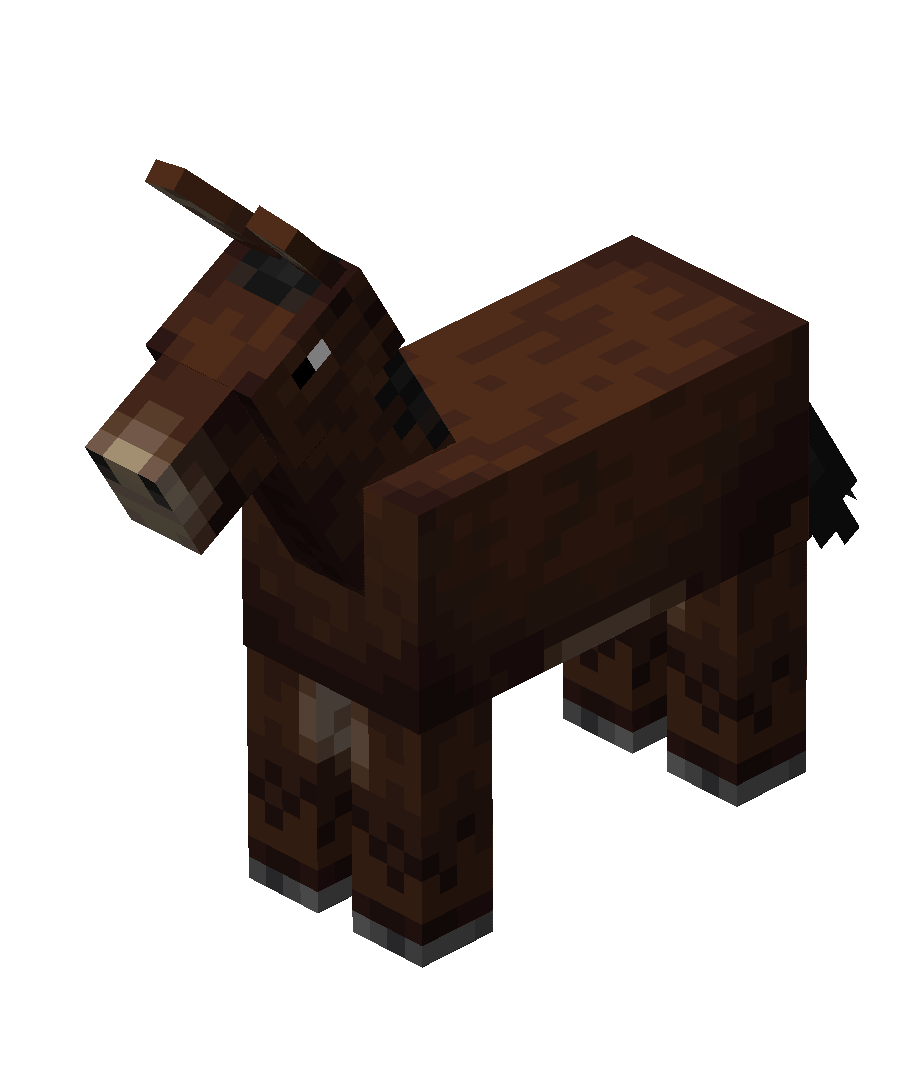
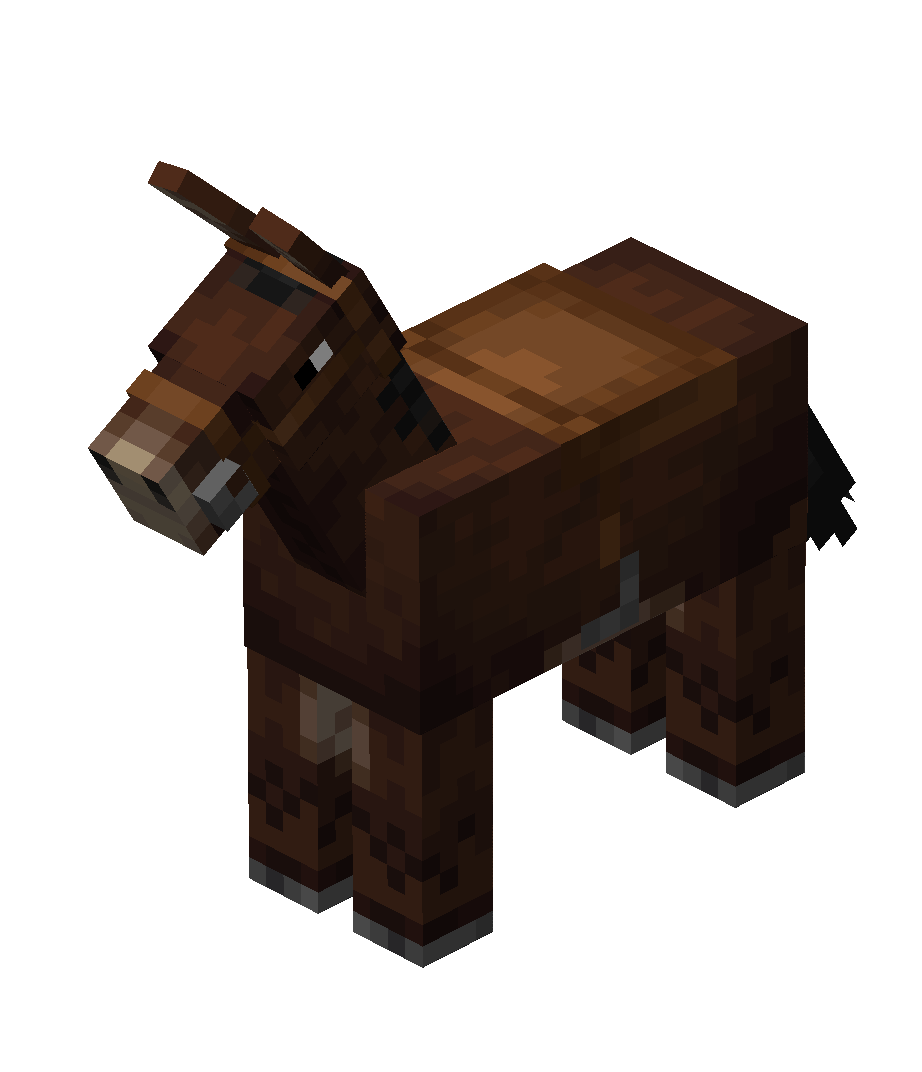
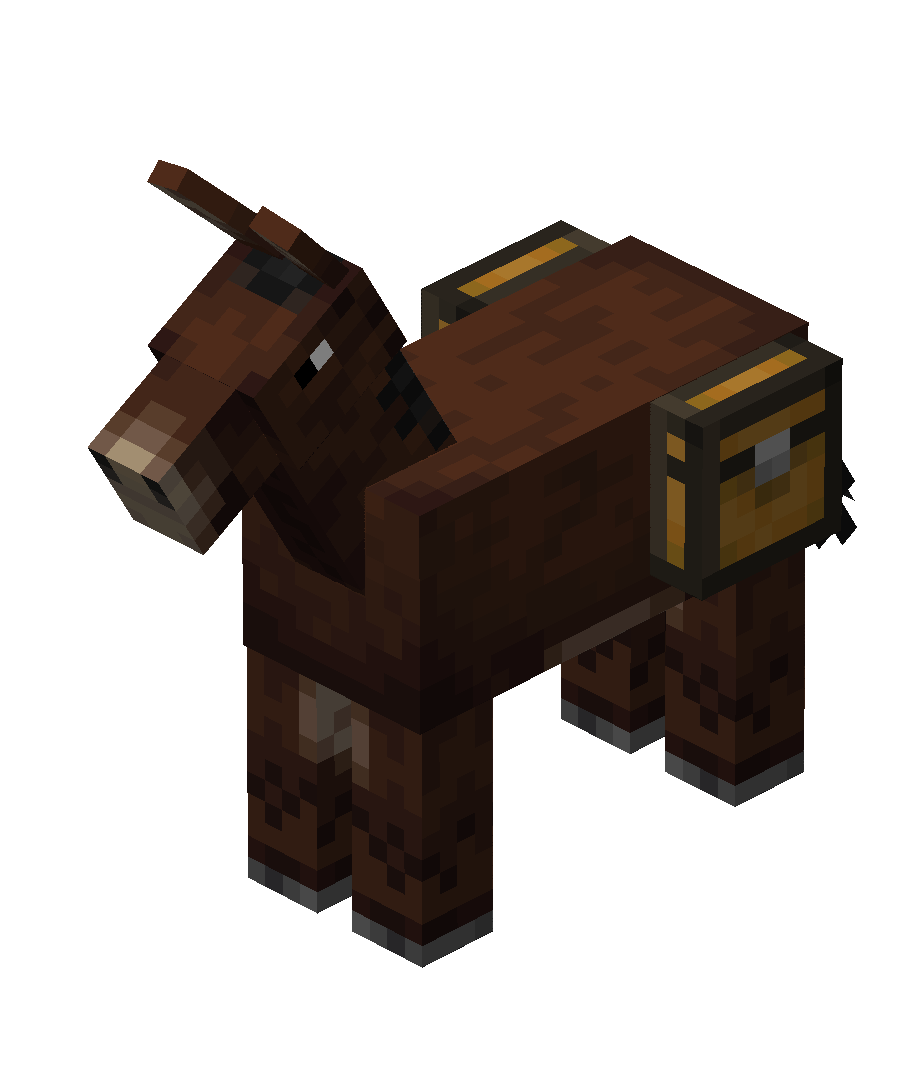
Adult:
Height: 1.6 Blocks
Width: 1.3965 Blocks
Baby:
Height: 0.8 Blocks
Width: 0.6982 Blocks
In Bedrock Edition:
Adult:
Height: 1.6 Blocks
Width: 1.4 Blocks
Baby:
Height: 0.8 Blocks
Width: 0.7 Blocks
When a horse and donkey breed
Mules are infertile offspring of horses and donkeys that, when tamed, can be ridden and equipped with chests.
Contents
Spawning [ ]
Mules do not spawn naturally, but they can spawn through cross-breeding a horse with a donkey. Mules cannot breed with other mules. 20% of mule spawn eggs produce foals.
Appearance [ ]
Mules are the offspring of horses and donkeys and are closer to (but not quite) the size of a normal horse. Their ears, coats, and manes are like those of a donkey, though mules’ coats are darker and reddish-brown. Like donkeys, mules cannot be equipped with armor but can be equipped with chests. Mules cannot have foals, much like mules in real life.
Unlike almost all other mobs, mules with equipped saddles or chests do not render these when under the effect of Invisibility. [1]
Drops [ ]
Upon death, mules drop:
If equipped with a chest or saddle, they drop those items, as well as any contents of the chest.
Usage [ ]
Mules can be equipped with chests and used as pack animals.
They can be pulled along and tied up using a lead, and can be towed, swimming behind a boat by using a lead.
Equipment [ ]
Tamed mules have the following slot available:
Mules can also be equipped with chests, however, these do not have a dedicated inventory slot. Foals cannot be equipped with anything.
Equipment can be placed on a mule by holding it and then right-clicking on the mule, or by accessing its inventory. A mule’s inventory can be accessed by mounting the mule and opening the player inventory or by sneak ing and then right-clicking on the mule. A mule starts out with just a saddle slot, but if it is given a chest, it acquires 15 more inventory slots that can hold anything the player wishes.
Chests can be given to a mule by using it with the chest in hand, and the chest cannot be removed except by killing the mule. Upon death, the mule drops the attached chest and its contents.
Riding [ ]
When riding a mule, the hunger bar is replaced by the mule’s health in survival or adventure mode. [ Java Edition only ] It uses a slightly different heart texture than the player’s health bar. The experience bar is replaced by the mule jump bar.
A player can use any item while riding a mule, including drinking or throwing potions; activating doors or redstone devices; using chests, crafting tables, and furnaces; breaking and placing blocks (although it is slightly slower); and attacking with melee weapons or bows.
A ridden mule automatically runs up any one block high slope. The mule and rider can safely fit through a space as low as 2.75 blocks high. Lower clearance risks suffocating the rider if the rider’s head enters a non-transparent block. The mule itself can enter gaps as low as 1.625 blocks high, but may itself take suffocation damage when clearance is less than 1.75 blocks. Mules cannot fit through a 1-block-wide gap.
The maximum speed of mules, when created by breeding a horse and a donkey, varies between 4.8375 blocks/second and 14.5125 blocks/second (compared to the player’s walking speed, which is about 4.3 blocks/second). About 68% of mules are able to go faster than a minecart. Any mule spawned with its spawn egg always has a speed of 7.525 blocks/second, which is slower than a minecart at full speed. Mules are slow-moving backward, and about as fast as the player when moving sideways.
A ridden mule can be made to jump and holding the control charges for a higher leap. Mules are not affected by jump boost beacons or potions. The standard dismount control dismounts from the mule, as does going in water deeper than two blocks. Just like the player, mules take fall damage when falling from heights.
It is impossible for a player to use a Nether portal while on a mule. It is possible, however, to enter the portal on the mule and then dismount, sending the mule through the portal on its own, or use a lead to position the mule, then push it through the portal.
Behavior [ ]
All mules roam idly, occasionally stopping to rear, swish their tails, or lower their heads as though eating the grass. Unlike sheep, the eating animation does not actually cause any grass to be consumed. Mules turn to look at any player that comes near. Any mule, even a wild one, allows itself to be attached to a lead without protest. However, if the player attempts to saddle an untamed mule, it rears and flails its front hooves.
Mules, like most mobs, can ride in a minecart and boat. Unlike other passive mobs, mules slowly regenerate health.
Taming [ ]
Adult mules can be tamed: with an empty hand, mount the mule repeatedly; when it no longer bucks the player and shows hearts, it is tamed. It is necessary to tame a mule in order to give it equipment or ride it for any length of time.
Taming depends on the mule’s «temper». Mules begin with a temper of 0 out of 100. When a player is riding the mule, a random number between 0 and 99 is chosen. The mule becomes tame if this number is less than the temper, otherwise, the temper is increased by 5 and the player is bucked off. Temper can also be increased by feeding the mule.
While riding an untamed mule, a galloping sound is audible, more or less rapid to give a general idea of the mule’s speed. It is unknown whether there is any indication of jump height before taming.
Like all tame animals, a death message is displayed to their owner if they are killed.
Breeding [ ]
Like their real-life counterparts, mules in Minecraft cannot produce offspring. The only way to produce a mule (other than using a spawn egg) is to cross-breed a horse with a donkey.
Feeding a mule food can alter its behavior, cause it to grow (if it is not yet an adult; foals normally take 20 minutes to fully mature if not fed), and/or restore its health. The table below lists the effects of the various foods mules eat.
To feed a mule, hold a valid food item and press use on the mule. If the food is invalid, the player simply mounts the mule. Mules can be fed only when feeding would have an effect, similar to other animals.
Statistics [ ]
Mules have three «equine stats» that vary from mule to mule: health, (maximum) movement speed, and jump strength. These stats are created once the mule is born or spawned, and are not affected by food.
Spawned values [ ]
When spawned in any way except breeding – for instance, using commands or using spawn eggs – mules are assigned their stats within certain ranges, specific according to their horse type.
Health [ ]
A mule’s health ranges from 15–30, but tends toward the average of 22–23. Displayed hearts are health, divided by two, rounded down. A mule with a non-even number of health points (15, 17, 19, etc.) does not show the last half-heart. If the mule has lost one fewer health point than the inflicted damage and did not regenerate, it has an odd number of health points, otherwise, it has an even number of health points.
Movement speed [ ]
Spawned mules’ speed is always 0.175; the player’s normal walking speed is 0.1. The speed listed does not include any status effect that affects the speed of a horse or a player. Bred mules have speed based on their parent’s speeds, like all other horse breeding.
See transportation to compare the speeds of various transportation methods.
Jump strength [ ]
Spawned mules’ jump strength is usually 0.5, which is enough to clear 1 9 ⁄16 blocks. Other jump strengths can be found in bred mules, depending on the statistics of the parents (as explained later).
Bred values [ ]
When breeding a horse and a donkey, the foal’s stats are determined by averaging both parent’s stats with a third set, randomly determined as horses’ stats are (i.e. add both parents’ stats with the random value and divide by 3). Any value for speed and jump strength applicable for a horse spawned naturally or with a spawn egg can be used for the third set.
Sounds [ ]
| Sound | Subtitles | Source | Description | Resource location | Translation key | Volume | Pitch | Attenuation distance |
|---|---|---|---|---|---|---|---|---|
| https://minecraft.fandom.com/wiki/File:Donkey_idle1.ogg https://minecraft.fandom.com/wiki/File:Donkey_idle2.ogg https://minecraft.fandom.com/wiki/File:Donkey_idle3.ogg | Mule hee-haws | ? | ? | entity.mule.ambient | subtitles.entity.mule.ambient | ? | ? | 16 |
| https://minecraft.fandom.com/wiki/File:Donkey_angry1.ogg https://minecraft.fandom.com/wiki/File:Donkey_angry2.ogg | Mule neighs | ? | ? | entity.mule.angry | subtitles.entity.mule.angry | ? | ? | 16 |
| https://minecraft.fandom.com/wiki/File:Chicken_plop.ogg | Mule Chest equips | ? | ? | entity.mule.chest | subtitles.entity.mule.chest | ? | ? | 16 |
| https://minecraft.fandom.com/wiki/File:Donkey_death.ogg | Mule dies | ? | ? | entity.mule.death | subtitles.entity.mule.death | ? | ? | 16 |
| https://minecraft.fandom.com/wiki/File:Donkey_hurt1.ogg https://minecraft.fandom.com/wiki/File:Donkey_hurt2.ogg https://minecraft.fandom.com/wiki/File:Donkey_hurt3.ogg | Mule hurts | ? | ? | entity.mule.hurt | subtitles.entity.mule.hurt | ? | ? | 16 |
Data values [ ]
| Name | Resource location | Translation key |
|---|---|---|
| Mule | mule | entity.minecraft.mule |
| Name | Resource location | Numeric ID | Translation key |
|---|---|---|---|
| Mule | mule | 25 | entity.mule.name |
Entity data [ ]
Mules have entity data associated with them that contain various properties.
Achievements [ ]
| Icon | Achievement | In-game description | Actual requirements (if different) | Gamerscore earned | Trophy type (PS4) | |
|---|---|---|---|---|---|---|
| PS4 | Other platforms | |||||
| Saddle Up | Tame a horse. | — | 20G | Bronze | ||
| Artificial Selection | Breed a mule from a horse and a donkey. | — | 30G | Bronze | ||
Advancements [ ]
| Icon | Advancement | In-game description | Parent | Actual requirements (if different) | Resource location |
|---|---|---|---|---|---|
 | The Parrots and the Bats | Breed two animals together | Husbandry | Breed a pair of any of these 22 mobs: |
A mule must be the result of breeding a horse and a donkey for this advancement as they are not breed-able together. Other breed-able mobs, if any, can be bred, but are ignored for this advancement.


A trader llama does not count as a llama, and a mule must be the result of breeding a horse and a donkey for this advancement as they are not breed-able together. Other breed-able mobs, if any, can be bred, but are ignored for this advancement.
Video [ ]
History [ ]
Issues [ ]
Issues relating to «Mule» are maintained on the bug tracker. Report issues there.
Minecraft Wiki
Из-за новой политики Microsoft в отношении сторонних ресурсов, Minecraft Wiki больше не является официальной. В связи с этим были внесены некоторые изменения, в том числе и обновлён логотип вики-проекта. Подробности на нашем Discord-сервере.
Разведение животных
«Они не перестают размножаться!» [1]
Разведение животных — это игровая механика, которая позволяет разводить животных одного вида при использовании определённой еды.
Содержание
Механика [ ]
Разные виды домашних животных требуют разную пищу для создания потомства:
Животные в пределах 16 блоков будут следовать за вами, если у персонажа в руках соответствующий предмет (кроме лис), если животное не приручаемое, если животное прирученное — то собаки будут наклонять голову, пытаясь привести вас в умиление, а кошки и лошади проигнорируют.
Животных можно снова разводить через 5 минут, хотя они, как и детёныш, могут следовать за игроком, держащим правильную еду. На то, чтобы животные выросли, уходит 20 минут, в течение которых они будут следовать за любыми взрослыми животными того же вида поблизости (чаще всего за родителями, так как они изначально близко).
Детёныш спаунится либо между родителями, либо на том же блоке, на котором находится то из животных, которое перешло в «режим любви» раньше.
Лис, в отличие от других животных, сложнее разводить, так как даже с ягодами в руках они все равно будут убегать. Но если у игрока это получилось, то родители скорее всего убегут, а детеныш лисицы будет игроку «доверять» и не станет убегать, но и преследовать как прирученный волк не будет.
Кошки [ ]
При разведении кошек у котенка будет окрас второго покормленного родителя, из чего выходит что новые виды получить таким образом нельзя.
Если две покормленные овцы разных цветов, то ребёнок унаследует комбинацию цветов родителей. Пример: совместив белую и красную овцу, на свет родится розовая овца. Если комбинация цветов невозможна, например коричневый и серый, то детеныш унаследует любой из двух цветов родителей. Если же цвета у родителей одинаковые, то ребенок будет цвета родителей.
Деревенские жители [ ]
Деревенские жители размножаются самостоятельно, если популяция в деревне меньше, чем максимум, определяемый количеством домов (или, по крайней мере, кроватей и рабочих мест, обладающих определёнными свойствами (до релиза 1.14 функцию кроватей здесь выполняли двери). Для размножения жителей в деревне должен быть фермер, собирающий урожай. Если его нет, то вам нужно давать жителям еду, выбрасывая её им под ноги. Маленькие деревенские жители, в отличие от большинства мобов, имеют головы, пропорциональные размеру тела.


